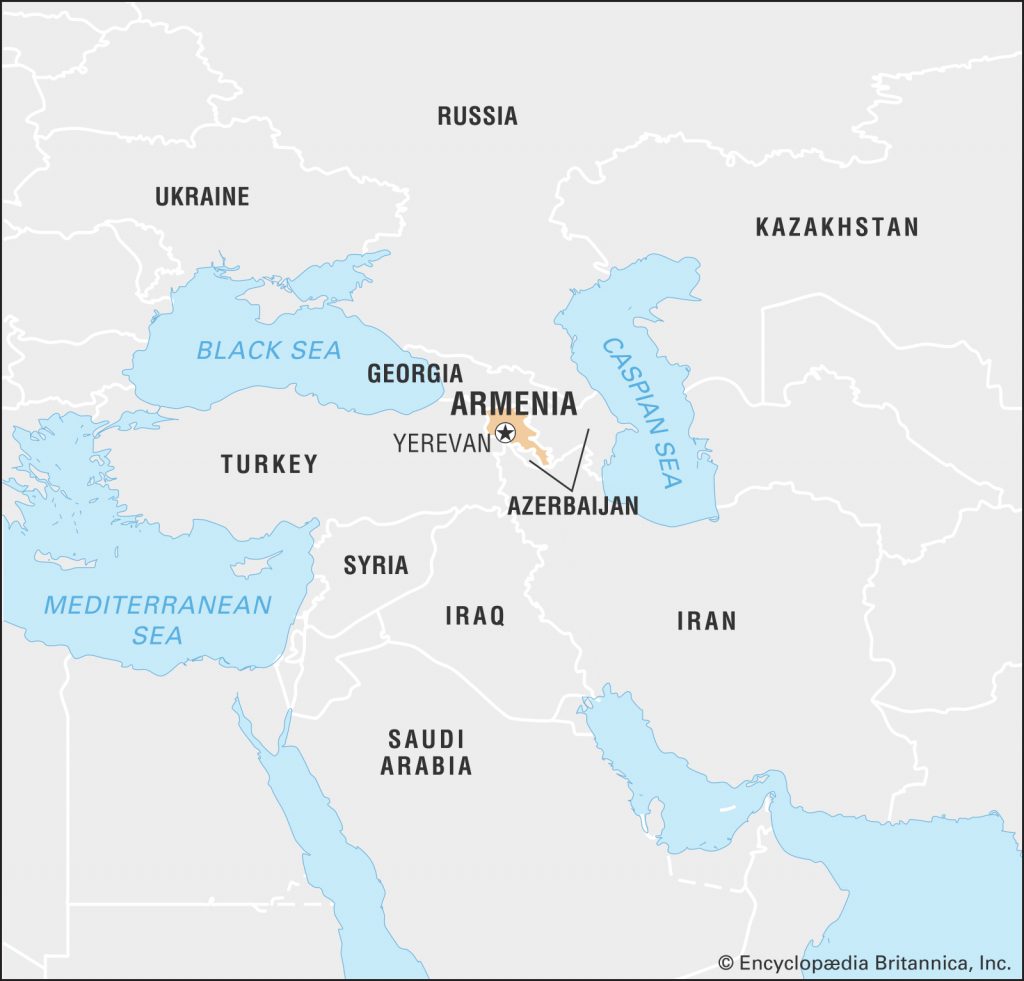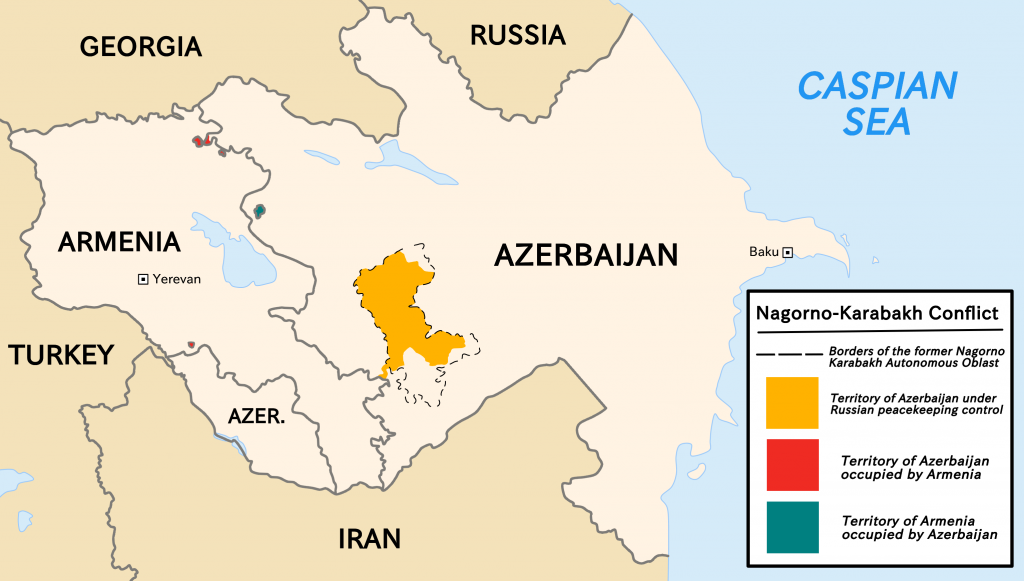Context:
Turkish President Recep Tayyip Erdogan said he will visit Azerbaijan to celebrate its victory over Armenia in a brief war in 2020, touring a region recaptured in disputed Nagorno-Karabakh.
Relevance:
Prelims, GS-II: International Relations (Important Foreign Policies and Developments), GS-I Geography (Maps), GS-I: History (World History)
Dimensions of the Article:
- Nagorno-Karabakh conflict
- About the 2020 Conflict
- How the ceasefire in 2020 was achieved?
Nagorno-Karabakh conflict
- The Nagorno-Karabakh conflict is an ethnic and territorial conflict between Armenia and Azerbaijan over the disputed region of Nagorno-Karabakh, inhabited mostly by ethnic Armenians, and seven surrounding districts, inhabited mostly by Azerbaijanis until their expulsion during the First Nagorno-Karabakh War between 1988 and 1994.
- The conflict has its origins in the early 20th century, though the present conflict began in 1988, when the Karabakh Armenians demanded that Karabakh be transferred from Soviet Azerbaijan to Soviet Armenia.
- During the dissolution of the Soviet Union in 1989, ethnic tensions between Armenians and Azerbaijanis increased in the Nagorno-Karabakh region.
- In the First Nagorno-Karabakh War, 1988-94 Armenia and Azerbaijan, both former Soviet Republics, entangled themselves in a protracted, undeclared war in the mountainous heights of Karabakh as Azerbaijan attempted to curb the secessionist movement in Nagorno-Karabakh.
- A ceasefire signed in 1994 provided for two decades of relative stability, which significantly deteriorated along with Azerbaijan’s increasing frustration with the status quo, at odds with Armenia’s efforts to cement it.
- A four-day escalation in 2016 became the deadliest ceasefire violation (until the 2020 conflict) and the 2016 fighting stopped with a ceasefire agreement in 2020 by which most of the territories lost by Azerbaijan during the First Nagorno-Karabakh war were returned to Azerbaijan.


About the 2020 Conflict
- In 1994, Russia mediated a ceasefire between Armenia and Azerbaijan, but the conflict has continued for three decades, with instances of ceasefire violations and violence instigated from both sides.
- In 2016, the region was particularly tense because of violent fighting between the two countries in what came to be known as the Four-Day War.
- Experts say the border between Armenia and Azerbaijan has been tense since 2018, particularly after Azerbaijan moved troops into the area, close to its border with Georgia.
- In a break from the violence that the disputed region has witnessed for over 30 years, this area had been relatively calm in 2018 and 19.
- It was not immediately clear what started the round of fighting in 2020, with multiple reports from the two countries reporting deaths of soldiers in the border.
- According to one report, Azerbaijan had said it had destroyed an Armenian fortification and artillery and had inflicted casualties on “hundreds” of Armenian soldiers, a claim that Armenia had denied. Armenia in turn said Azerbaijan had triggered the conflict.
How the ceasefire in 2020 was achieved?
- Russia, which has a security agreement with Armenia, remained neutral in the early days of the war when Turkey threw its weight behind Azerbaijan. Russia brokered a ceasefire two weeks into the conflict, but it didn’t hold.
- Later, Russia established small military outposts along the Armenian border, apparently to prevent the conflict spilling into mainland Armenia and also to send a message to Baku.
- Also, Russia conducted a massive air strike in Syria’s Idlib against Turkish-backed militants, killing dozens of them, which is seen as Moscow’s warning against Turkey.
- Russian President Putin accepted Azerbaijan’s victory (as the ceasefire allows Azeri troops to control the territories they have seized) but prevented a total defeat of Armenia. Under pressure from a decisive Moscow, both sides agreed to cease the operations.
What are the terms of the ceasefire?
- According to the ceasefire, Armenia agreed to withdraw its troops from much of the territories around Nagorno-Karabakh.
- The core of the enclave with ethnic Armenians and Stepanakert as its capital would remain outside the control of Azerbaijan.
- Baku will build a road linking the newly captured territories to Nakhchivan, an autonomous republic of Azerbaijan which had been geographically separated from the mainland.
- As the broker of the truce, Russia would send some 2,000 peacekeepers to the region, who would patrol between the Azeri troops and Nagorno-Karabakh, including the Lachin corridor, which connects the enclave with Armenia.
- Basically, Azerbaijan gained territories, but not the whole of Nagorno-Karabakh.
- Armenia lost territories it controlled since the 1990s but avoided a total defeat as much of Nagorno-Karabakh would remain independent of Azeri control.
- And Russia gained a bigger foothold in the region with its troops being deployed within Azerbaijan.

-Source: The Hindu




